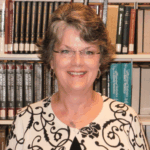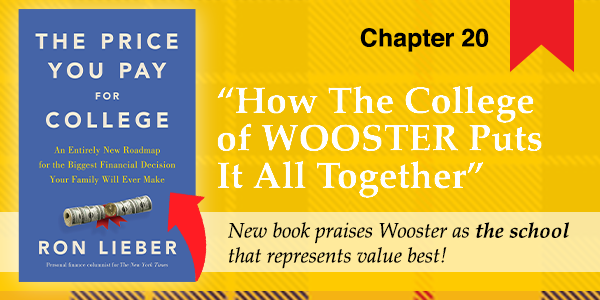
New Book Lauds Wooster As The School That Best Represents Value

“The Price You Pay for College: An Entirely New Road Map for the Biggest Financial Decision Your Family Will Ever Make”—a new book released today by author Ron Lieber, personal finance columnist for The New York Times to help readers navigate the college search process, praises The College of Wooster as the school that best represents value.
In his book, Lieber shares his two decades of research on how we should determine the value of college and what things are worth paying for. In addition to the cost of attendance, he looks at what and how students will learn, the diversity of peers and mentors with whom they will develop life-long relationships, and the credentials and career prospects they will earn upon graduation. He discusses the importance of other value-adds like on-campus health centers, small class sizes, career counseling, and good food options.
The author dedicates an entire chapter in his section on value to explaining “How The College of Wooster Puts It All Together,” weaving in conversations with Wooster’s President Sarah Bolton and Vice President for Enrollment Scott Friedhoff, parents, current students, as well as alumni. Lieber chronicles everything from Wooster’s transparent merit-aid process and the human-centered admission process to the faculty-student mentoring experience and the College’s signature Independent Study (I.S.) program—even making a pit stop to share key takeaways from Wooster’s annual I.S. Symposium (he calls it our “Academic Woodstock”!), where students share the results of their yearlong research or creative endeavors.
“It’s rewarding to see others continuing to take notice of what we’ve always known about the power of Wooster’s truly unique commitment – ensuring that every student, in every major, works one-on-one with a faculty mentor to create new knowledge or art” said Sarah Bolton. “What a great tribute to our faculty, staff, trustees, alumni, and donors who make what we do for our students possible year-after-year.”
A few noteworthy Wooster mentions from Lieber’s “The Price You Pay for College,” include:
On Wooster’s Small Classes and Faculty-Student Mentoring Relationships
Lieber says there are “a variety of aspects of the college experience that are worth a whole lot of money under the very best circumstances. For instance, real professors who stand a chance of becoming mentors are worth paying extra for, and your odds of finding them are higher at colleges with smaller classes.”
As relates to Wooster, he continues: “This idea of being seen-truly seen-ought to count for something… All of this takes a lot of faculty time. This is expensive, and the one-on-one work involved means that there are fewer upper-level classes than there might be elsewhere. Yet look at Wooster’s financial statistics via the federal College Scorecard website. The average annual cost for people receiving federal aid of any sort is $25,000, about what a flagship state university might cost at full price. Nearly all students get merit aid, even if they have no demonstrated financial need; the average merit figure for people who have no need is $26,400, subtracted from a total undiscounted cost of attendance of $66,750.”
Asked by Lieber how Wooster’s approach to faculty-student mentoring compares to a larger university’s President Sarah Bolton replies, “… You will not be invisible if you don’t want to be invisible here. Faculty will know when you’re trying and know when you are not and will push you beyond what you imagined you could do.”
On Wooster’s Transparent Merit Aid Process
Lieber refers to Wooster’s Early Aid Estimator (available to high school juniors this spring) a tool provided to students early on in the college search process to provide them a personalized projected aid award prior to applying, as “quite a radical level of transparency for higher education institutions.”
He explains, “Wooster also offers a concierge service of sorts to which you can reach out before applying. When you access it, a human being from the enrollment staff sizes up your merit and need-based eligibility and essentially makes you a nonbinding financial offer. This is a far cry from the approach of most other schools, especially some of the more selective merit aid-granting ones, where the size of the discount may well stay a mystery until after you are granted admission.”
On Wooster’s Independent Study Program
“Wooster, Ohio, about an hour’s drive south of Cleveland, is just big enough to be a city, not a town, and to have an excellent third-wave coffee shop. And if the College of Wooster is known for anything, it is for its Independent Study, or “I.S.,” rendered in capital letters to distinguish it from the undistinguished mass of option undergraduate senior theses that students churn out at other schools. At Wooster, every senior completes one; some undertake two at once. The school describes I.S. as a class of one, where you meet weekly with a faculty member with the goal of producing something entirely original: fiction, data from a lab, art that fills an entire wall of a large gallery. Much of the work that undergraduates do in Wooster classrooms during their first three years is to prepare them for this final yearlong intellectual journey.”
Every year since 2002 U.S. News & World Report has asked college presidents and deans to name schools with outstanding undergraduate research opportunities and senior capstone programs, only two schools have made both lists every year: Wooster and Princeton. Learn more about Wooster’s approach to mentored undergraduate research in every major.
Posted in News on January 26, 2021.


